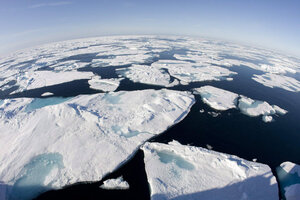What's going on with polar ice sheets?
With the Arctic and Antarctic experiencing below average, if not record-low, sea-ice coverage, climate and polar researchers are scrambling to quantify how ice loss could affect global sea levels.

This file photo made with a fisheye lens shows ice floes in Baffin Bay above the Arctic Circle, seen from the Canadian Coast Guard icebreaker Louis S. St-Laurent, July 10, 2008.
Jonathan Hayward/The Canadian Press/AP/File
Recent measurements show that the Arctic’s sea ice extent in January was the lowest ever in the satellite record, while the Antarctic also saw lower than average ice coverage last month and a major ice sheet there could be verging on instability.
The reports come at a time when climate and polar researchers are investigating the potential for heavy melting of ice sheets in the Arctic and Antarctic, and the effects the loss of the ice could have on global sea levels.
According to the National Snow and Ice Data Center (NSIDC), January’s sea ice extent in the Arctic averaged 5.2 million square miles, down from the more than 5.6-million-square-mile average observed between 1981 and 2010. The previous January low came in 2011; this month’s mark was around 35,000 square miles less than that record.
The NSIDC, which researches and manages data about frozen regions around the globe and their climates, says the drop varied significantly from highs observed last January. The month’s unusually high temperatures, which were caused by a strong negative phase arctic oscillation – a variance in air pressure between the poles and more central latitudes – led to the extremely low ice coverage throughout much of the Arctic region.
The Barents, Kara, and East Greenland seas had “unusually low ice coverage,” and less than average coverage in the Bering Sea and Sea of Okhotsk was observed. Ice in the waters surrounding most of northeastern Canada and western Greenland were reported to be “near average.”
This data continues a negative decade-over-decade trend for January. The month’s average now sits at negative 3.2 percent every decade based on data collected since 1979. It also continues a trend of a less than 5.5-million-square-mile extent reported in each consecutive January since 2005.
Despite what appears to be a consistent downward tendency in sea ice extent, a recent study published in Geophysical Research Letters suggests that the rate of Arctic ice loss may actually be slowing, at least in the Atlantic. Even though the January trend is on a negative trajectory, a tendency for more ice overall has been observed since 2005.
“There is little doubt that we will see a decline in Arctic sea ice cover in this century in response to anthropogenic warming,” according to the research letter. However, “internal climate variations and other external forcings could generate considerable spread in Arctic sea ice trends on decadal timescales.”
This research is supported by analysis of Meridional Overturning Circulation in the Atlantic, ocean patterns that circulate warm water to the Arctic and reduce the ice extent. While the study focuses on the Atlantic’s circulation, warming waters on the other side of the pole could persist.
Another recently released study concerning an Antarctic ice sheet could also point to changes in ice levels at that pole and its effects on global waters. The West Antarctic Ice Sheet (WAIS), “considered the major contributor to global sea level rise” tens of thousands of years ago, could be primed to repeat history if the effects of greenhouse gases partially melt or collapse the sheet. The WAIS could have added several meters to seawater levels globally at a time when polar temperatures averaged 2 degrees Celsius higher than they are today.
While the researchers behind the study and its simulations are still not certain about the effects of the potential WAIS melt, “Given a business-as-usual scenario of global warming, the collapse of the West Antarctic could proceed very rapidly and the West Antarctic ice masses could completely disappear within the next 1,000 years,” according to lead author Johannes Sutter of the Alfred Wegener Institute for Polar and Marine Research.
The study estimates that the melt could lead to a sea level increase of 3 to 5 meters, notwithstanding a the potential for a rise of several more if ice at the Arctic pole also continues to disappear.

